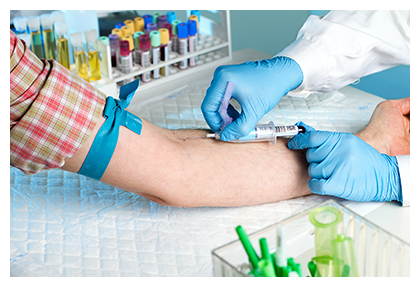DWI cases involving blood test are very common all over Texas. If you refuse to take a breath test, chances are very good that law enforcement will get a search warrant to take your blood. Some agencies are phasing out breath tests, while others don’t even offer. Gone are the days in which in you refuse to blow, police are left without a test. In Fort Worth and other cities in Tarrant County, where I primarily practice, it is extremely rare for a DWI case to have no test. The analytical method that analyzes whole blood for alcohol content is called gas chromatography. The science of gas chromatography can be reliable and accurate, but there are many areas of potential for error in a blood test. Any time there are people involved in the testing, there will be potential for error. Someone manufactures the blood tubes. A person draws the blood. A person prepares the blood sample for testing. A person programs and calibrates the gas chromatograph. This article is about blood draws and issues that can arise before blood is analyzed—how blood gets from a human body into the syringe needle of the gas chromatograph.

Three Major Areas of Error in Blood Draws
This heart of analytical chemistry is the reliability of the result. If the result is unreliable in any way, it is meaningless in every way. There are three major areas of possible error regarding blood draws—there are pre-draw issues, issues with the blood draw itself, and post-draw issues. Error and mistake can creep in and compromise the reliability and accuracy of the result at any of these stages. From a defense perspective, the importance of knowing what errors to look for cannot be understated. It is very important to the defense. There is potential for error before the blood is drawn, during the blood draw, with how your blood is drawn, and after the blood is drawn but before it is tested. This article examines these errors and issues that can arise in the pre-analytical stage in a DWI case involving a blood test.
What are Pre-Draw Issues?
Police officers and state agencies have blood kits in their patrol cars. When an officer makes an arrest for DWI, the officer transports the arrestee and the blood kit to a hospital. According to Texas Law, only certain persons can take a specimen of blood[i]. Usually, it is a registered nurse. This is another issue altogether. There are many items in a blood kit. In the Texas DPS kit, there are around a dozen items. These items include the collection tube, protective containers, absorbent material, mailing labels and submission forms. One item that is not included in any blood kit is the needle, which is provided by the hospital. It is important to ask where the blood draw kit is kept prior to use. How secure is the storage? At what temperature is the storage? Most inserts recommend that kits remain stored at a temperature between 39 and 77 degrees Fahrenheit. In Texas, it gets hot so this is an important consideration. Especially if the blood kit has been stashed in the trunk of a patrol car.
The Contents of a Blood Tube
There are different kinds of blood tubes for all sorts of medical tests. Becton Dickinson (BD) is a leading manufacturer of blood tubes for medical testing. They make many of the tubes used around the state for ethanol forensic testing. BD makes tubes with tops of all different colors to indicate different purposes. Blood tubes that used for ethanol testing are very specific. They have grey tops. In the absence of a blood kit, medical personnel are directed to use a grey-top tube. If the wrong one is used, it will not have correct chemicals in the correct ratio, and this will affect the results. These tubes have small amounts of chemicals that are designed to prevent fermentation and coagulation. Sodium fluoride is an antiglycolytic agent to prevent glycolysis, which is the breakdown of glucose. This is supposed to prevent fermentation and the creation of new alcohol. Potassium oxalate is inside the tube to prevent coagulation or blood clotting. If there is blood clotting, the test will be artificially high because the machine will no longer be testing whole blood. Furthermore, if the tube is expired, that could also affect the validity of the test. The anticoagulant and the preservative don’t last forever, and there is an expiration date on the collection tube. However, the expiration date on the tube has to do with vacuum of the tube. The tube is designed to extract 10 milliliters of whole blood. This is very important because if there is more than 10 milliliters or less than 10 milliliters of blood in the tube, that will definitely destroy the validity of the test.
What are Blood Draw Issues?
For a blood draw to be admissible in court, it must be taken by a person specifically authorized to do so by Section 724.017 of the Transportation Code. This can be a doctor or a nurse or a certified technician or an emergency medical technician. The blood also must be drawn in a sanitary place. Usually, the person drawing the blood is a registered nurse. The process of taking the blood must also be performed correctly to be valid and reliable. Choosing the draw site for venipuncture is the first step. BD recommends that the best sites for venipuncture are the superficial veins of the arm. The median cubital vein runs down the inside of the forearm and is most commonly used for venipuncture. The cephalic vein on either the forearm or the bicep and the basilic vein along the forearm are also acceptable areas for venipuncture. BD warns that several areas are inappropriate as draw sites, and these include hematomas or scarred areas. Another thing to think about is that venous blood is always drawn, and it will be higher in ethanol than arterial blood.
How to Disinfect the Draw Site
The person who takes the blood must disinfect the draw site. This is very important. Many household and workplace antibacterial solutions contain alcohol as a primary ingredient. This is highly inappropriate for forensic blood draws for obvious reasons. Ethanol can get into the tube and destroy the integrity of the sample. Good cleaning technique is to use povidone iodine pads and to disinfect the draw and move the pad along the skin in a circular motion, pushing contaminants away. It is inappropriate to simply move the pad back and forth over the skin. This pushes contaminants back and forth and could contaminate the result.
Serum and Whole Blood
Forensic testing of blood is intended to test whole blood and not serum. If serum is tested instead of whole blood, this will invalidate the test. Ethanol is hydrophilic. This means that ethanol has a strong affinity for water. Ethanol molecules move toward the water and concentrate there. Whole blood is 80% water. Serum and plasma are 92% water. Serum will have a higher concentration of ethanol than whole blood, and can create a falsely high reading. Coagulation can also result in serum testing. The potassium oxalate is the anticoagulant present in the collection tube, but if the integrity of the collection tube is compromised, clotting can result. Hemolysis can also result in serum or plasma testing. Hemolysis occurs when the membranes of red blood cells break hemoglobin is released. Improper specimen collection or processing or handling can cause hemolysis. If the blood is not drawn at the correct vein, or the draw site is not disinfected correctly, hemolysis can result. After the blood is drawn, the blood tube must be gently shaken so that the sodium fluoride and potassium oxalate can properly mix. This is called inversion, and the tube must be inverted 8 or 10 times to properly mix everything. However, vigorous shaking of the tube can cause hemolysis.
What are Post-Draw Issues?
Labs that run a lot of cases on the gas chromatogram and the mass spectrometer get backed up. Often there are delays that means blood tubes are waiting to be tested. The blood tubes are refrigerated while they wait to be tested. If they are not refrigerated, this is a serious problem that can compromise the validity of the test. What happens to the ethanol content in the blood after the draw and before the test? Ethanol content can evaporate from the tube, and the resulting test can be lower. This can happen if there is a bad seal on the tube. However, lower temperatures will generally inhibit ethanol loss.
Neo-Fermentation
Ethanol can increase in the blood tube after the blood draw but before the test. This is true with or without refrigeration. Ethanol content can also increase in the tube, after the draw. This is a frightening notion. Neo-fermentation is the creation of new alcohol in the tube, after the draw. Neo-fermentation occurs when a microorganism capable of producing alcohol interacts with an appropriate substrate in the blood, such as glucose. Candida albicans is a fungus that exists on human skin and is capable of producing alcohol. There are a lot of different sources for neo-formation—methanol, acetone, isopropanol—that can increase ethanol. However, candida albicans is the usual suspect. Ethanol happens in the tube after the draw when candida albicans and glucose combine. Studies have shown that sodium fluoride is ineffective to prevent ethanol production by candida albicans. Samples must be brought to room temperature before analysis. Studies have shown that specimens that contain candida albicans and are stored at room temperature for more than 5 days showed substantial neo-fermentation.









